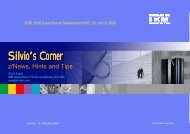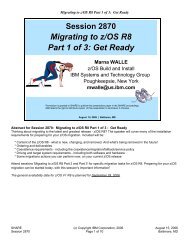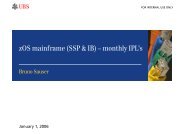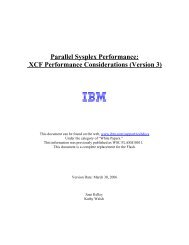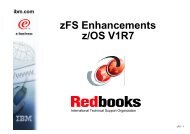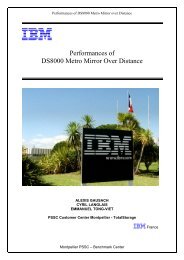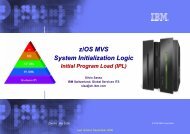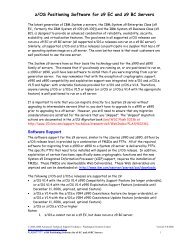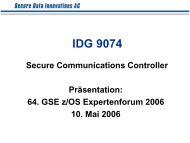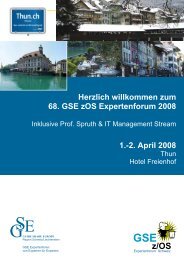Hot Topics - Messmer The Brain House
Hot Topics - Messmer The Brain House
Hot Topics - Messmer The Brain House
Create successful ePaper yourself
Turn your PDF publications into a flip-book with our unique Google optimized e-Paper software.
Storage made easy<br />
Answers that won’t drive you nuts<br />
BY EDWARD BAKER AND SEAN MCMILLEN<br />
z/OS system programmers, z/OS storage<br />
administrators and independent software<br />
vendors are asking IBM some typical<br />
questions about storage. Let’s take a look:<br />
Dear IBM,<br />
I use tape mount management (TMM)<br />
heavily in my shop. This is in order to<br />
minimize the number of tape mounts and<br />
maximize the usage of my tape resources<br />
during tape mounts. I have noticed<br />
that these tape mount management<br />
data sets are not eligible for the fast<br />
subsequent migration (FSM) function. Is<br />
there anything that one can do to allow<br />
these data sets to be candidates for fast<br />
subsequent migration?<br />
Thanks,<br />
Mr. Tapemount<br />
Dear Mr. Tapemount,<br />
You are in luck; beginning in z/OS<br />
R7 we have implemented changes to fast<br />
subsequent migration that can solve your<br />
common dilemma. As you’re aware, fast<br />
subsequent migration is a function that<br />
allows data sets that have been recalled<br />
from migration level 2 (ML2) tape to be<br />
reconnected to the initial place of origin<br />
on that ML2 tape. This is only possible if<br />
the data set was not modified since being<br />
recalled. In a tape mount management<br />
(TMM) environment, data sets are<br />
normally assigned to a management class<br />
or storage group that does not require<br />
backup. You were most likely encountering<br />
this problem because no valid backup copy<br />
typically exists for data sets in a TMM<br />
environment.<br />
In z/OS V1R7, DFSMShsm, with<br />
assistance from other z/OS DFSMS<br />
components, developed a more rigorous<br />
FSM design that allows TMM-type data<br />
to be reconnected. In fact, even data<br />
sets without a valid backup copy are now<br />
eligible for fast subsequent migration as<br />
long as the data set remains unaltered<br />
since the recall. Let us know how this<br />
enhancement works for you!<br />
Thanks,<br />
IBMer<br />
To DFSMShsm Development,<br />
I utilize your HMIGRATE command<br />
daily. Typically, it’s when I am about to<br />
leave work and I want to migrate all my<br />
L0 volume data sets that I used that day.<br />
I migrate most of my data sets to ML1<br />
DASD, or even sometimes ML2 tape.<br />
When I found out that I could use partially<br />
qualified data set names on the command<br />
with the use of filters (also known as<br />
wildcards) I was ecstatic. This allowed me<br />
to accomplish all migrations with a single<br />
command. Because I don’t reuse every<br />
single data set created every day, I often<br />
find that I get an annoying error message.<br />
<strong>The</strong> error message appears for every data<br />
set that meets the filter criteria that is<br />
already migrated. Is there a way to<br />
turn off notification of all these error<br />
messages? I really like using the<br />
HMIGRATE with wildcards (*).<br />
Thank you,<br />
Mrs. Migrate<br />
Dear Mrs. Migrate,<br />
We understand your request, and<br />
we have an answer for it beginning<br />
in DFSMShsm V1R7. We will no<br />
longer issue the ARC1224I message for<br />
data sets already migrated to ML1 when<br />
you use the HMIGRATE command with<br />
partially qualified data set names and<br />
filters.<br />
Additionally, you will no longer see<br />
the ARC1282I error message when the<br />
data set already resides on an ML2 tape<br />
volume. This eliminates the multitude of<br />
error messages that you receive during<br />
your migration processing. By the way, we<br />
also implemented the bypassing of error<br />
messages whether or not you specify the<br />
ML2 parameter on your HMIGRATE<br />
command. Try it out and let us know what<br />
you think.<br />
Thanks,<br />
HSM Development<br />
To IBM,<br />
We have recently invested in your<br />
latest high capacity tape media, the IBM<br />
TotalStorage® 3592 Tape Cartridges. I<br />
find it just phenomenal that you can put<br />
300 GB of uncompressed data on a single<br />
tape these days. I remember back when the<br />
3480s came out in 1984 and the capacity<br />
was 200 MB of data. Back in those days<br />
that was a whole lot of data (ha-ha!).<br />
Anyway, we have found that DFSMShsm<br />
has not been filling our larger tapes to<br />
their full capacity. We see this primarily<br />
when we place hundreds of thousands<br />
February 2006 z/OS HOT TOPICS Newsletter, Issue 14 49



